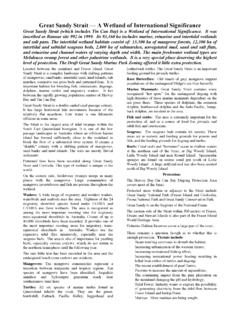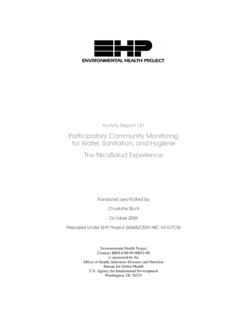Transcription of What has World Heritage meant for Fraser Island?
1 What has World Heritage meant for Fraser Island? By John Sinclair. (Honorary Project Officer, Fraser Island Defenders Organisation) Abstract Fraser Island was inscribed on the World Heritage List in 1992. With 99 percent of the island being a National Park its natural integrity should be ensured in perpetuity. This paper critically evaluates the management of the island and the arrangements between the State and Commonwealth Governments and how this has failed to protect the values for which it has been internationally recognized and some significant environmental degradation that has ensued. Visitation has increased by more than 50% since listing, resulting in a huge diversion of the proportion of public expenditure on Fraser Island from natural resources management to recreation management.
2 Visitor pressure continues to impact on the island s natural resources, potentially threatening its World Heritage values. Lakes suffer from infilling and in the deteriorating water quality. Dingo management has become a major issue only since the Listing. The number of weed species continues to increase despite increasing efforts to control them. Fire ecologists continue to argue that the fire regime is far from optimal due to a lack of priority and resources. Climate change is already visibly impacting on the island s environment but less research and monitoring now occurs on Fraser Island than before World Heritage listing. Despite the establishment of advisory committees to facilitate communication with stakeholders, there is now less transparency over Fraser Island management than during the 1990s.
3 This paper seriously questions that World Heritage listing has benefited Fraser Island. o0o 1. IntroductionFraser Island was known to the Butchulla people as Kgari for millennia. It is the World s largest coastal sandmass and contains complex, evolving coastal dune formation. (FIWHSAC 2004). However, it is not just its physical traits that have earned it World Heritage status (its outstanding biodiversity and geomorphology have also been recognized (DSEWPC 2009).After a 21-year campaign for World Heritage , Fraser Island was listed in 1992. Commercial logging ceased in 1991 and the Great Sandy Region Management Plan was adopted in 1994, and since 1998 management of 99 percent of the island has been a National Fraser Island s surface area of 163,000 hectares, all but a few consist of siliceous sand.)
4 The highest dune has an elevation of 240 metres. The sand extends up to 90 m below present sea level (CICMUFIGSR 1990). The only rock occurring is a few exposed hectares of volcanic remnants in the Indian Head-Waddy Point area and a smaller metamorphic intertidal outcrop at the mouth of Boon Boon Creek (ACF 1975). With a length of 123 kilometres and an average breadth of 14 kilometres, Fraser Island contains the tallest rainforests growing on dunes in the World (FIWHSAC 2004). It has extensive areas of rainforests, eucalypt woodlands, forests and heathlands. It also features dune lakes, tidal wetlands and over 200 kilometres of wide sandy beaches. (DSEWPC 2009).
5 Despite over 120 years of exploitation of its precious forests and the disturbance of about 350 hectares to extract mineral sands, Fraser Island still retains most of its outstanding natural qualities. Although the island attracts about 350,000 visitors annually (MOONBI 116 2007), according to residents contacted in three villages there are still fewer than 100 permanent residents. Almost all visitors are conveyed around the island in four-wheel drive transport. (GHD 2002)2. Recent History of Conflict on Fraser IslandFraser Island has been the subject of considerable controversy as competing interests waged very public campaigns over the exploitation of its mineral sands and timber resources.
6 (Bonyhady 1993). Following a six year campaign by conservationists wanting to preserve the island as a complete natural ecosystem for posterity and acting on the recommendations of the Fraser Island Environmental Inquiry that conducted a six month comprehensive multidisciplinary inquiry throughout 1975, the Commonwealth Government in 1976 banned the export of mineral sands from the island which effectively ended the sandmining industry there despite the Queensland Government heavily backing the industry (FIEI 1976)The Inquiry had also recommended that Fraser Island should be nominated for World Heritage listing. However the timber industry had been operating on Fraser Island since 1863.
7 The Queensland Government heavily backed the logging and the Commonwealth Government lacked constitutional powers to over-ride the Queensland Government on this issue as it had in the case of mineral sands. (Bonyhady 1993, Sinclair & Corris 1994, Lines 2006) Queensland s position stalled the island being nominated for World Heritage for 10 years. As a result of political changes, the Queensland Government in 1990 appointed a Commission of Inquiry into the Conservation, Management and Use of Fraser Island and the Great Sandy Region headed by Tony Fitzgerald QC to consider the merits of the claims of Fraser Island and Cooloola for World Heritage listing and also the sustainability of the timber industry on the island.
8 After a most detailed examination of all submissions the inquiry recommended that the whole of the Great Sandy Region deserved World Heritage nomination and that the timber industry be phased out (Fitzgerald 1991). Logging ceased in December 1991 and Fraser Island was inscribed on the World Heritage List in December 1992. Unfortunately the whole Great Sandy Region including Cooloola wasn t included in the area inscribed on the World Heritage List. However, both the State and Federal governments are now committed to pursuing again the inclusion of Cooloola and a much larger marine area in a World Heritage renomination that will also recognize additional values not recognized in 1992.
9 (Jones 2010)3. World Heritage ValuesWhen listed in 1992, Fraser Island was deemed to have met two of the criteria for World Heritage listing. (DEWHA 2010). The criteria for World Heritage have since been redefined and Fraser Island is now deemed to meet three of the four natural criteria: What has World Heritage Listing meant for Fraser Island? 2 Criterion (vii) contain superlative natural phenomena or areas of exceptional natural beauty and aesthetic importance; Criterion (viii) to be outstanding examples representing major stages of earth's history, including the record of life, significant on-going geological processes in the development of landforms, or significant geomorphic or physiographic features; Criterion (ix) to be outstanding examples representing significant on-going ecological and biological processes in the evolution and development of terrestrial, fresh water, coastal and marine ecosystems and communities of plants and animals.
10 In 2010 these were summarized in a Statement of Outstanding Universal Values: Fraser Island, (Kgari) the World s largest sand island is an outstanding example of complex dune formations evolving from a unique interaction of coastal successional vegetation, hydrological and geomorphological systems. The island contains close to half the World s known freshwater dune lakes. It is an area of exceptional natural beauty, with spectacular tall rainforests and sandy beaches, wallum heath, tidal wetlands, and diverse terrestrial and aquatic fauna including acid frogs, shorebirds, dugong, turtle and whales. (DEWHA 2010). These values have been elaborated in greater detail in a statement yet to be endorsed by the World Heritage Committee (DERM pers.)




